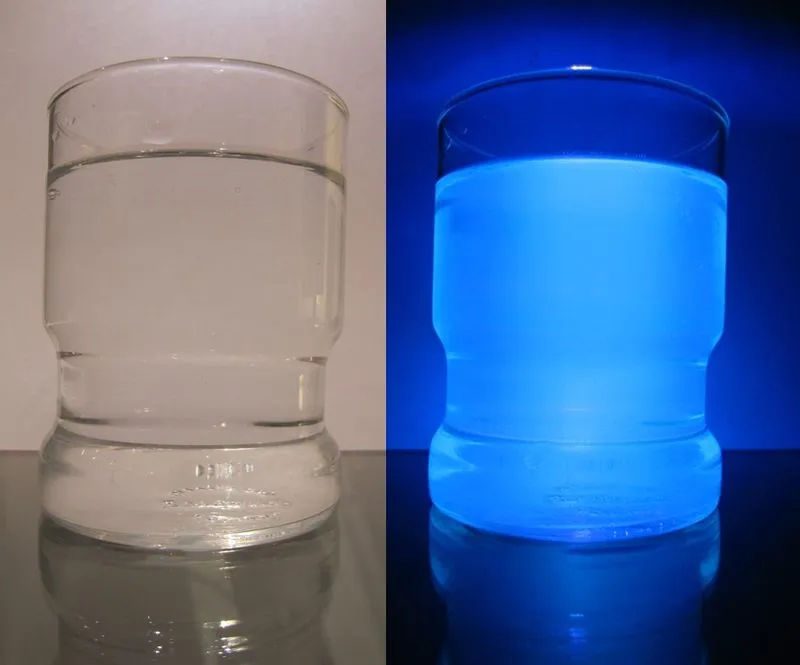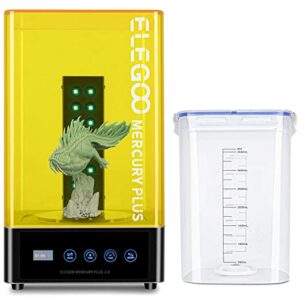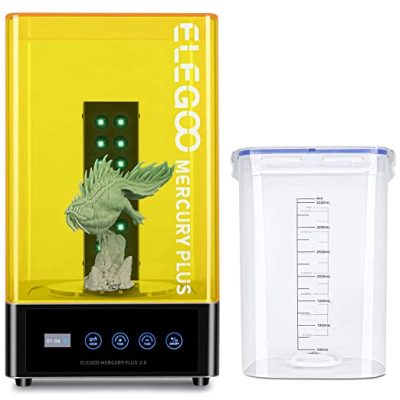- Last Updated: January 12, 2024
-
 Jackson O'Connell
Jackson O'Connell

If you have a resin 3D printer, then you probably know the importance of curing models. This process entails exposing a resin 3D print to UV light for a few minutes to ensure all of the photopolymer resin material is solidified.
Skipping the UV curing process for a print made on an SLA/DLP (resin) 3D printer will yield a soft, potentially-hazardous part. Uncured resin prints are not only weak but also dangerous to touch because the resin, which is considered toxic, is still not solid. Additionally, uncured models typically look less sharp around small details.
As such, it’s extremely important that you have a UV light for curing your resin prints. There are many different UV light options, but my favorite is Elegoo Mercury Plus V2.0. This light system is very well-designed, with a decently-large containment area, a powerful UV light strip, and a rotating bed. The Mercury Plus V2.0 also comes with a special container for washing 3D prints, another integral part of the resin 3D printing process.
The Anycubic Wash & Cure Plus station is another great option, and it also serves as both a UV curing and a washing system. And, if you’re on a budget, check out the Comgrow UV curing lamp; it’s not as advanced a system as some of the other options, but it’s very low-cost.
For more of the best UV lights for curing resin prints, just keep reading!
Table of Contents
- Top UV Curing Lights At A Glance In 2024
- What is a UV Curing Box?
- UV Resin VS Epoxy Resin
- How UV Light Helps with Resin 3D Prints?
- Why Do I Need to Cure Resin Prints?
- How Long to Cure Resin Prints?
- What is the Best UV Wavelength for Curing Resin?
- Is it Possible to Cure Without UV Light?
- Is Resin Still Toxic After Curing?
- Considerations for UV Curing Lights
- Bottom Line
Top UV Curing Lights At A Glance In 2024
1. Elegoo Mercury Plus V2 (Best Choice)
2. Comgrow UV Resin Curing Light (Best Value)
3. Anycubic Wash & Cure Plus (Premium Choice)
4. SainSmart Curing Box (Largest)
5. Sovol 3D SL1
6. UltraFire UV Flashlight
First up, we have the Elegoo Mercury Plus V2.0. Designed by Elegoo, a leading voice in the consumer resin 3D printing space, the Mercury Plus V2.0 is the perfect option for anyone with a consumer-level resin printer, like an Elegoo Mars 3 or a Phrozen Sonic Mini.
The UV curing station offers a decently large containment space so you can cure (and wash) many large resin 3D prints. As for the UV curing abilities, the Mercury Plus V2.0 is packing heat, equipped with two 8-piece strips of powerful UV lights that can effectively cure your model so that it’s ready to be used in the real world.
Plus, the Mercury Plus V2.0, like many curing stations nowadays, has a rotating disk bed. This feature allows models placed on the bed to be evenly cured, so its entire surface is solidified and not just the area where the lights are pointing towards.

I should also note that the Elegoo Mercury Plus V2.0 doubles as a part washing station too. Moreover, the kit comes with a Tupperware-like container that’s about the same size as the curing container and is meant to be filled with either water or a solvent (e.g. acetone) to wash resin 3D prints. For reference, you should wash your model before curing it.
Finally, I want to point out the awesome and easy-to-use control panel on the Mercury Plus V2.0. The device has four buttons for controlling the power, curing time, and curing mode. There’s also a tiny LCD that displays the time so you can check how much longer your prints have left in the curing chamber.
Overall, the Mercury Plus V2.0 is the perfect option for anyone who has a resin 3D printer and needs to handle the post-processing side. The Mercury Plus V2.0 serves as both a UV curing and a washing station and it has enough space for even the larger models that come off the print bed.
Second, Comgrow is a company involved with 3D printing, CNC machining, and a handful of other hobbyist activities. Their UV resin curing light is a very good low-budget option for anyone looking for a way to cure UV resin prints.
Unlike the Mercurcy Plus V2.0 and the other options on this list, the Comgrow UV resin light system doesn’t have an enclosed chamber. Instead, it’s just a UV lamp that comes with a rotating disk bed where you can place your prints.
But don’t be scared away by the Comgrow UV light’s lacking of visual attractiveness. The UV lamp is still very effective for curing your resin prints, with six high-power UV light bulbs. And, because the product comes with a rotating disk for your 3D print, your parts will be cured evenly.
One thing to note though, is that when using the UV lamp, make sure to position it the proper distance from the rotating disk where your 3D print is. You want the light to reach all areas of your 3D model, not just the bottom.
And, the best part about the lamp is it costs under $30, which is a total steal. So, if you’re getting into resin 3D printing and need a way to cure your prints without spending too much dough, definitely give the Comgrow UV resin curing light a shot!
Third, Anycubic is another major player in the consumer 3D printing space, and the Anycubic Wash & Cure Plus station is perhaps one of the best options for a UV light.
As indicated by the name, this product serves as both a UV curing and a print washing station, just like the Mercurcy Plus V2.0. And, like the Mercury Plus V2.0, the Anycubic Wash & Cure Plus is also decently large; it has an available containment space measuring 192 x 120 x 290 mm, which should be more than enough space for curing large 3D prints.
But my favorite feature of the Anycubic Wash & Cure Plus station is its UV light bar, which is innovatively L-shaped. The L-shaped light bar has a hinge near the top that makes it easy to cure the top surface of a model, which is traditionally difficult to cure. This yields higher-quality 3D prints than other UV curing lamps which fail to cure the top surface.

Of course, the product also has a rotating disk bed, too, so models will be pretty evenly cured.
The product also has a sensor that detects when the enclosure is attached, so the UV light will automatically shut off when the enclosure is off. This was done to protect people’s eyesight and is a feature that’s not always on these types of products.
The interface on the Anycubic Wash & Cure Plus station is also very easy to use, with a knob that can be used to set a timer, change washing modes, and more! On this note, I want to point out that the wash feature on this product uses the rotating disk motor to move the water (or solvent) in the container to better wash the 3D print in the bin, again yielding higher-quality prints than other curing stations.
So if you’re looking to maximize the quality of your prints and are comfortable spending a little extra, then I strongly suggest getting the Anycubic Wash & Cure station.
The largest curing box on this list comes from SainSmart, yet another manufacturer of 3D printing supplies. The SainSmart Curing Box is surprisingly budget-friendly and offers a ton of space, allowing you to cure even the largest 3D prints. Moreover, the available space inside the SainSmart curing box measures 310 x 310 x 310 mm, which is larger than any other option on this list.
And, despite its large size, the SainSmart curing box is also pretty light and portable due to the box’s foldable panel design.

The SainSmart curing box has excellent UV light projection abilities as its equipped with four 4-piece UV light strips, placed around the inside of the box. And the entire inside of the SainSmart curing box is reflective, which helps the light reach all sides of the inserted 3D print to achieve the highest-quality model.
The interface on this device is also super simple, consisting of a knob button and a small LCD. You can use the controls to start a timer for the UV lights so you don’t have to set a separate timer on your phone or watch.
Next, the Sovol 3D SL1 is another great curing box and it’s the one I use on a day-to-day basis. The SL1 isn’t super large, but it’s perfect for small and mid-size prints. And it costs under $50, which is very affordable!
The SL1 curing box has a rotatable disk on the inside with two long strips of UV lights along the side of the device and a small UV light strip on the top as well. Plus the inside of the curing box is reflective! For all of these reasons, the Sovol 3D SL1 does an excellent job at curing 3D prints.

To control the device, you can use the touchscreen-like interface on the top of the SL1. There are three pre-set options for the curing time (2, 4, and 6 minutes), as well as some other buttons!
Overall, the Sovol 3D SL1 is the perfect UV light box for curing resin 3D prints, and it’s both affordable and effective!
Lastly, the UltraFire UV Flashlight is a handheld UV flashlight that you can use to solidify your resin 3D prints. To be completely honest, this flashlight, while it looks really cool, isn’t nearly as effective at curing resin 3D prints as a typical UV curing box like the Sovol 3D SL1. This is mainly because the UV light is very centered around one spot and, obviously, there’s no mechanism on the device to spin the model.
Because simply shining the UV flashlight towards the model won’t effectively cure the entire part, it’s recommended that you manually rotate the model every 30 seconds or so to achieve an even surface cure. Of course, this manual labor is somewhat annoying. But if you really need to save money, then it might be worth it.
Also, it’s worth noting that the flashlight comes with a battery, but, according to reviews, you’ll likely have to charge it frequently as projecting UV light consumes a lot of power.
But, I should point out that because this product is a flashlight, you can use it for more than just 3D printing purposes. For example, you can use the UV flashlight to check fake I.D.s or identify pet urine stains.
What is a UV Curing Box?

A UV curing box is an enclosed container with a light projector on the inside that shines UV light at the inserted 3D prints. UV curing boxes make up most of the UV curing light market.
However, there are still some UV lights, like the Comgrow UV lamp, that aren’t UV curing boxes because they aren’t enclosed.
UV curing boxes typically work better than a standalone UV lamp, though, because they offer a more controlled curing environment. Moreover, no dust or other contaminant particles will get near your print if it’s in an enclosed space.
UV Resin VS Epoxy Resin

A common confusion people has is between UV photopolymer resin and Epoxy resin. Let’s go over the differences!
UV resin, also called photopolymer resin, is the material used for SLA and DLP 3D printers (resin printers). This resin material is usually purposed for 3D printing and solidifies when exposed to 405nm light waves.
On the other hand, Epoxy resin is another type of resin that isn’t usually UV-sensitive and is mainly used for the purpose of adhering two surfaces together. Epoxy resin is often used to bond multiple 3D printed objects together, but it’s not an actual 3D printing resin.
How UV Light Helps with Resin 3D Prints?

UV light helps with resin 3D prints by solidifying the material.
As I’ve mentioned, the material used on “resin” 3D printers (SLA/DLP machines) is photopolymer resin, which is sensitive to UV light. When exposed to UV light (usually at 405 nanometers), this resin material turns from liquid form to solid form.
During the 3D printing process, a series of precise UV light projectors are used to solidify resin in a selective manner to form your designed part. However, once the model is completed on the printer, it must be washed to remove any excess resin on the outer surface of the model and then exposed to more UV light to ensure all resin that’s supposed to be on the model is completely solid.
Why Do I Need to Cure Resin Prints?

If you don’t cure your finished and washed resin 3D prints, then the parts will be weaker, softer, and also more dangerous.
Moreover, after a model has been printed and washed, there will almost definitely be some areas of the part that are still not 100% solid and need to be cured. Failure to cure UV resin in these areas will keep them soft (rather than rigid), making your overall model weaker and more fragile.
When a resin model isn’t cured, typically it also looks a little less sharp and a bit more blobby. So, if you want high-quality, heavily-detailed models, make sure to get a UV light!
Additionally, because uncured, liquid resin is considered toxic, an uncured resin print is more dangerous, and shouldn’t be touched by bare skin.
And if that’s not enough to convince you to cure your resin prints, then I don’t know what will!
How Long to Cure Resin Prints?

How long you expose your 3D print to UV light is known as the curing time and there is no single best curing time. Instead, you should decide on a curing time based on the overall size of your 3D print.
Large 3D printed models should have a longer curing time and vice-versa.
For small and mid-size 3D prints, I suggest going with 3 minutes and adding on another minute if the model still feels soft. And, for large 3D prints, I’d say try 5 minutes.
Check out our article on this exact topic how long to cure resin prints for more info.
What is the Best UV Wavelength for Curing Resin?
The best UV wavelength for curing resin is 405 nanometers (nm). I’m not really sure if this is the best wavelength, but this is the wavelength that’s recommended by 99% of all 3D printer and resin manufacturers. So, unless otherwise specified by a manufacturer, make sure that all UV light sources you use to run at 405 nm.
Is it Possible to Cure Without UV Light?
Yes!
As you probably know, the sun produces UV light. While it’s not recommended nowadays, you can actually leave your resin 3D print out under the sun for a few hours to cure it without a UV light device.
Of course, this isn’t the best idea because the sun isn’t as regulated in its UV light projection as a UV lamp. But, if conditions are right, it gets the job done. Most people who use the sun for curing resin prints suggest leaving your model out for 2-5 hours under the sun.
Is Resin Still Toxic After Curing?
Though resin in liquid form is considered very toxic, once cured, the photopolymer material is basically harmless. I won’t go into the science of how this transition from toxic to non-toxic occurs, but, once a resin print is properly cured with UV light, it’s safe to touch with bare skin.
Considerations for UV Curing Lights
When picking out a UV curing light, there are a handful of factors to keep in mind. I’ve gone over the most important ones below:
Wavelength
Wavelength is a metric of a light wave that’s very relevant for resin 3D printing. Almost all consumer resin printers and UV curing lights project at a wavelength of 405 nanometers, as this falls on the UV light spectrum and works well with photopolymer 3D printing resin. As such, make sure that the UV light you buy projects light at 405 nm.
Number of UV Lights
The more UV lights on a curing device, the more effective it is at curing 3D prints. While there’s no minimum number of UV light pieces that a curing device needs to have, most UV curing boxes feature at least 8 light projector pieces.
Container Size
If you want a UV curing box (an enclosed container with a UV light), then you should consider the size of the containment space. Obviously, if you plan on printing larger resin 3D prints, then you should look for a UV curing box that has a larger container size.
Value
Finally, value is extremely important to consider!
I like to think of value as the feature per dollar. So, if you spend more, you should get a product that has more features or better capabilities. When choosing what UV curing light to get, make sure to look for a good bang for your buck!
Bottom Line
Overall, curing a resin 3D print is absolutely essential if you want the 3D print to be strong, look good, and not damage your skin. Curing resin 3D prints is also super easy. All you need is a UV light and a few minutes!
My favorite UV light for curing resin 3D prints is the Elegoo Mercury Plus V2.0, which also doubles as a washing system. The Mercury Plus V2.0 has 16 total UV lights and a rotatable disk bed, which, together, do a great job at ensuring every model is cured evenly. The washing feature on the device is also terrific!
Similar to the Mercurcy Plus V2.0, the Anycubic Wash & Cure Plus station also can both wash and cure prints. The machine costs a bit more than the Mercury but its L-shaped light bar and motorized washing abilities definitely make it worth it.
Finally, if you’re looking for a more budget-friendly UV light for curing resin 3D prints, then consider the Comgrow UV resin curing lamp. The lamp is very powerful, so though it doesn’t have an enclosure, your prints will still be solidified and cured. Plus, it comes with a rotatable disk!
Enjoy!














